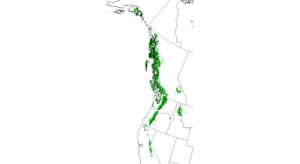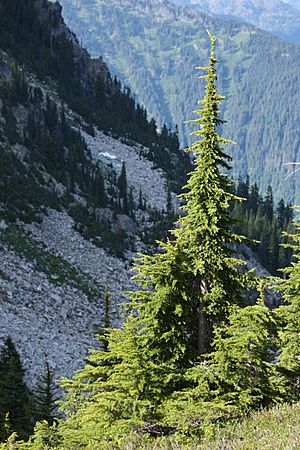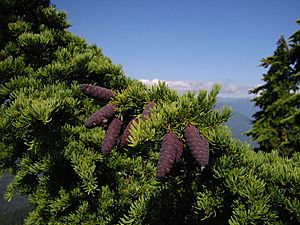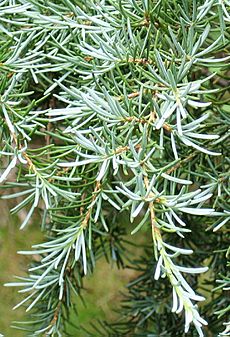Tsuga mertensiana facts for kids
Quick facts for kids Tsuga mertensiana |
|
|---|---|
 |
|
| Mountain hemlock in Turnagain Pass, Alaska |
|
| Conservation status | |
| Scientific classification | |
| Genus: |
Tsuga
|
| Species: |
mertensiana
|
 |
|
| Natural range of Tsuga mertensiana | |
The mountain hemlock (scientific name: Tsuga mertensiana) is a type of hemlock tree. It grows naturally along the west coast of North America. You can find it from the Kenai Peninsula in Alaska all the way down to northern Tulare County, California. The name mertensiana honors Karl Heinrich Mertens, a German botanist who first collected samples of this tree in the 1820s.
Contents
About the Mountain Hemlock Tree
The mountain hemlock is a large evergreen tree. This means it keeps its needles all year round. It's a coniferous tree, which means it grows cones. These trees usually grow to be 20 to 40 meters (about 65 to 130 feet) tall. Some special ones can even reach 59 meters (about 193 feet) tall! Their trunks can be up to 2 meters (about 6.5 feet) wide.
The tree's bark is thin and gray. It often has square cracks or grooves. Young trees have a neat, cone-shaped top with a slightly tilted or drooping main branch. As they get older, their shape becomes more like a cylinder. You can always spot a mountain hemlock by its branch tips, which hang down a little.
The new shoots are orange-brown and covered in tiny hairs. The leaves are like needles, about 7 to 25 millimeters (0.3 to 1 inch) long. They are soft, have blunt tips, and are a pale blue-green color. They have two wide bands of bluish-white stomata (tiny pores for breathing) on the underside. What makes them special is that they also have stomata on their upper surface, unlike other hemlocks. The needles grow in a spiral pattern all around the shoot.
The cones are small and hang down. They are shaped like cylinders and are 30 to 80 millimeters (1.2 to 3.1 inches) long when closed. When they open, they can be 12 to 35 millimeters (0.5 to 1.4 inches) wide. They look a bit like small spruce cones. The cones have thin, bendy scales. Young cones are dark purple, but they turn red-brown about 5 to 7 months after the tree is pollinated. The seeds inside are red-brown and have a thin, pale pink-brown wing that helps them fly in the wind.
Where Mountain Hemlocks Grow

The mountain hemlock grows in many of the same places as the western hemlock. Most of these areas are less than 100 kilometers (about 60 miles) from the Pacific Ocean. However, you can also find them inland in the Rocky Mountains in places like southeast British Columbia, northern Idaho, and western Montana. These inland trees likely spread there a long time ago after the ice age (called deglaciation), traveling more than 200 km (124 miles) from the coast.
In California, the western hemlock mostly grows in the Pacific Coast Ranges, but the mountain hemlock is found in the Klamath Mountains and Sierra Nevada. Unlike the western hemlock, the mountain hemlock usually grows at high altitudes. In Alaska, it can grow from sea level up to 1,000 meters (3,280 feet). In the Cascades in Oregon, it grows between 1,600 to 2,300 meters (5,250 to 7,550 feet). In the Sierra Nevada, it's found even higher, from 2,500 to 3,050 meters (8,200 to 10,000 feet).
Types of Mountain Hemlock
There are three main types, or taxa, of mountain hemlock: two subspecies and one smaller variety.
- Northern mountain hemlock (Tsuga mertensiana subsp. mertensiana): This type grows from central Oregon northward. Its cones are smaller, 30 to 60 millimeters (1.2 to 2.4 inches) long, and have 50 to 80 scales.
- Tsuga mertensiana subsp. mertensiana var. mertensiana: This is the most common northern mountain hemlock. Its needles are gray-green on both sides.
- Tsuga mertensiana subsp. mertensiana var. jeffreyi: This variety is rare and grows mixed with the common northern type. Its needles are greener on top and paler underneath. Its cones look the same as the main type. People once thought it was a hybrid with western hemlock, but there's no proof of this.
- California mountain hemlock (Tsuga mertensiana subsp. grandicona): This type grows from central Oregon southward. Its needles are very strongly blue-green. Its cones are larger, 45 to 80 millimeters (1.8 to 3.1 inches) long, and have 40 to 60 scales.
Mountain Hemlock's Environment
Mountain hemlock trees usually live in cold, snowy mountain areas, often called the subalpine zone. They grow slowly, sometimes living for more than 800 years! Young trees have narrow, cone-shaped tops. Older trees, and those growing in windy, cold spots near the tree line (called krummholz), add beauty to mountain views.
These trees like a cool to cold maritime climate. This means they get mild to cold winters, a short, warm-to-cool growing season, and a good amount of rain or snow.
Mountain hemlocks grow best in loose, well-drained soils that have enough moisture. In British Columbia, they also do well in thick, very acidic soil made of organic matter and decayed wood. Having enough moisture in the soil is very important, especially in California and Montana, where summers can be quite dry.

These trees can grow on most landforms. However, they grow best when mixed with other trees on sheltered slopes or in valleys. From southern British Columbia south, they prefer slopes that face north. This need for moist, cool places becomes even more important in western Montana, where the climate is more continental, and in the central Sierra Nevada, where it's more mediterranean. In these areas, mountain hemlocks often grow in small groups in north-facing valleys and bowl-shaped areas (called cirque basins) where snow collects and stays late into summer.
Mountain hemlocks are good at living in places with long-lasting snowpacks. In spring, mountain hemlocks can start to breathe (called transpiring) even when they are sticking out of 2 to 4 meters (6.5 to 13 feet) of snow. Other trees nearby, like whitebark pine, won't start transpiring until the snow under them has melted. Mountain hemlocks are also good at handling heavy snow and ice on their branches. Their strong branches and drooping branchlets help the snow slide off easily.
Mountain hemlocks can handle shade and competition from other plants. They are more tolerant than most other trees they grow with, except for Pacific silver fir, western hemlock, and Alaska cedar. Mountain hemlock is considered a "climax species" in most of its habitats. This means it's one of the main trees that will grow there over a long time. However, it's also one of the first trees to grow on new land like glacial moraines in British Columbia and Alaska.
Mountain hemlock often grows after other trees like lodgepole pine or subalpine fir have started growing in drier areas. It also tends to replace Engelmann spruce when they grow together. This might be because hemlock can better handle the chemicals spruce trees release that can harm other plants.
Growing Mountain Hemlock Trees
Outside of its natural home, the mountain hemlock is grown as an ornamental tree. This means people plant it for its beauty. It's used in native plant landscapes in California. It's also popular in gardens in northern Great Britain and Scandinavia. People like it for its blue-green color and because it can handle tough weather. However, it's not grown everywhere because young plants grow very slowly and they don't do well with city air pollution.
Several special types, called cultivars, have been chosen for their very blue-green needles. Some of these include:
- 'Blue Star'
- 'Glauca'Template:KIDDLE XL START
See also
 In Spanish: Cicuta de montaña para niños Template:KIDDLE XL END
In Spanish: Cicuta de montaña para niños Template:KIDDLE XL END




